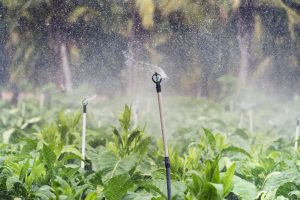
Irrigation is the process/method of adding water to crops artificially in order to consummate their water requirements. It is a method of artificially supplying water to plants, crops, and landscapes in order to ensure their proper growth and health, especially in areas where natural rainfall is insufficient or inconsistent. It plays a crucial role in agriculture, horticulture, landscaping, and even in maintaining green spaces in urban environments. These systems are designed to efficiently distribute water to the plants’ root zones, reducing water wastage and ensuring optimal water usage. There are various types of water sources for irrigation like wells, ponds, lakes, tube wells, and dams.
Methods of Irrigation.
There are two main methods of irrigation: the traditional method and the modern method.
The traditional method is the process through which the farmer waters the field or farm himself by pulling out water from the well or ponds himself.
The modern method is in two forms: drip system and sprinkler system.
Drip system is a precise and efficient method of delivering water directly to the root zone of plants, typically in agricultural and landscaping settings. This technique uses a network of tubing, pipes, and emitters to distribute water, minimizing water wastage and promoting water conservation.
Sprinkler system is a method of artificially applying water to crops, plants, or landscapes by distributing it in the form of small water droplets sprayed from a system of pipes, tubing, and nozzles. This method simulates natural rainfall, providing efficient coverage over a designated area.

Advantages of Irrigation.
- Water Efficiency: The systems are designed to deliver water directly to the root zones of plants, minimizing water wastage through evaporation and runoff. This targeted application helps conserve water and can lead to significant water savings compared to traditional manual watering methods.
- Consistent Water Supply: It provides a reliable and consistent water supply to plants, ensuring that they receive the required amount of water at the right time. This consistency is particularly important for maintaining healthy growth and preventing stress due to drought or excessive moisture.
- Labour Savings: Automated irrigation systems reduce the need for manual labor in watering plants. This is especially advantageous for large-scale agricultural operations, commercial landscapes, and homeowners who would otherwise spend significant time and effort watering their plants by hand.
- Time Savings: It saves time by eliminating the need for daily manual watering. This time can be allocated to other important tasks, such as crop management, maintenance, and expansion of planting areas.
- Flexibility and Precision: Modern irrigation systems can be programmed to deliver water based on specific plant needs, soil conditions, and weather patterns. This precision ensures that each plant receives the right amount of water, optimizing growth and reducing the risk of overwatering or underwatering.
Disadvantages of irrigation system
While this system offer numerous benefits, there are also some disadvantages and challenges associated with their use. Here are some potential drawbacks of irrigation systems:
- Initial Cost: The installation of an irrigation system can involve a significant upfront investment, including the cost of equipment, materials, labor, and system design. This cost can be a barrier for small-scale farmers, homeowners, and businesses with limited budgets.
- Maintenance Expenses: It requires regular maintenance to ensure they function efficiently. This can involve costs for repairs, replacing worn-out components, cleaning filters, and adjusting system settings. Over time, maintenance costs can add up.
- Technical Knowledge: Properly designing and managing an it requires a certain level of technical knowledge and expertise. If not designed or operated correctly, the system may lead to uneven water distribution, overwatering, or underwatering, affecting plant health and growth.
- Energy Consumption: Many irrigation systems, especially pressurized systems like sprinklers, require energy to operate pumps, valves, and other components. This energy consumption can contribute to operational costs and have environmental implications.
- Risk of Overwatering and Underwatering: If not properly calibrated or managed, it can lead to overwatering (which can cause root rot, nutrient leaching, and fungal diseases) or underwatering (resulting in stunted growth, reduced yields, and plant stress).
Featured Images Credit: Wikimedia
Image Credit: Flickr


